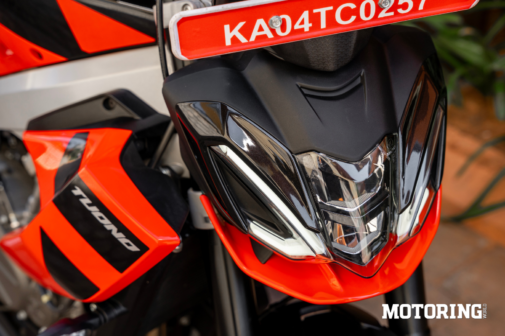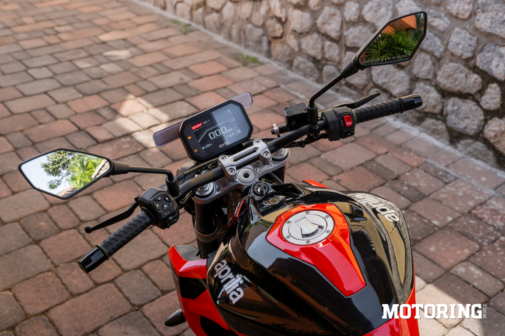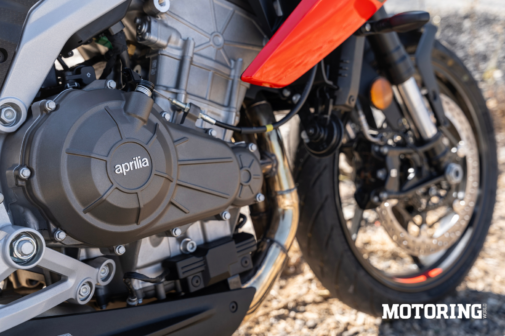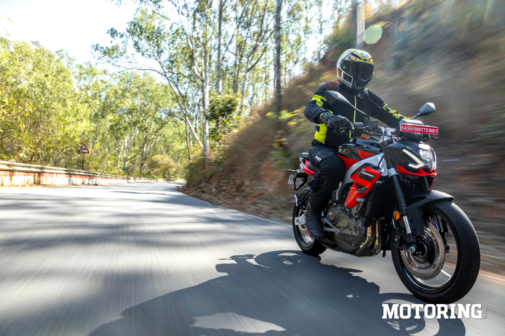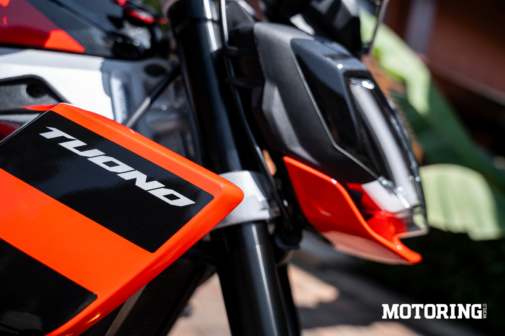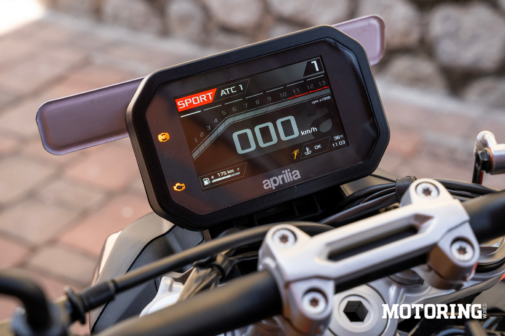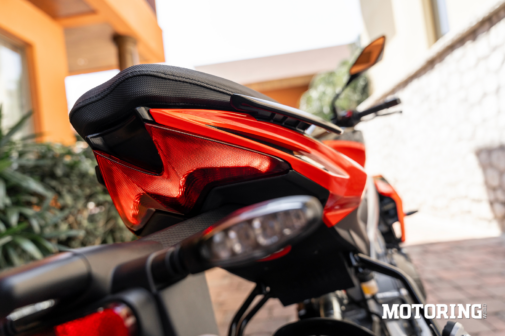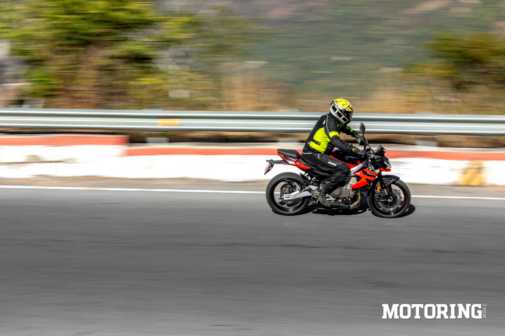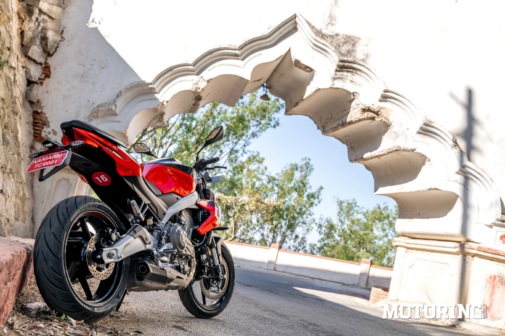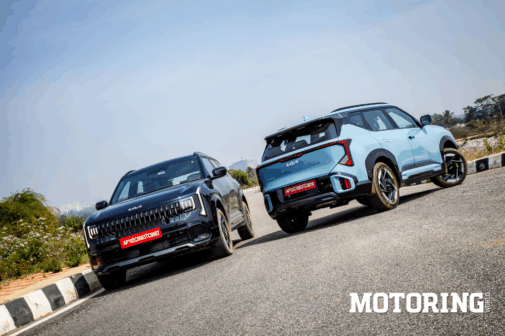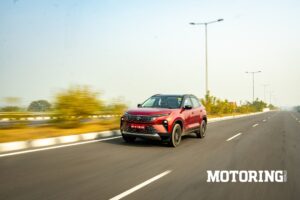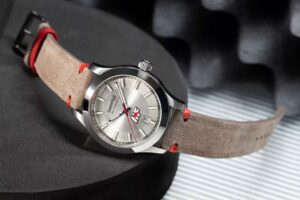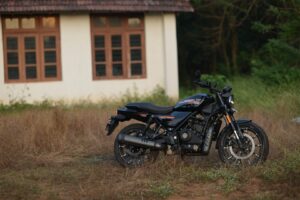‘It’s rather nice to not have my thumbs trapped between clip-on ’bars and the tank.’ That was the first thought that came to mind when I sat on the Aprilia Tuono 457 and turned its handlebar lock to lock. And after letting the naked bike inhale the long-gone Nandi Hill Climb’s serpentine uphill run, I watched the Tuono’s stainless-steel exhaust headers as they seemed to turn golden before my very eyes. In just a couple of hours, the Tuono had proved to be a most willing comrade in full-throttle arms. And it was this very friendliness that made me wonder what hill-climb racers of yore would’ve achieved on a motorcycle as potent as this up that road.
The newest Tuono is little more than an RS 457 with a street-/paunch-friendly handlebar – but it feels like it’s a lot more than that. Comfort does matter, after all, doesn’t it? Okay, maybe the distance between the seat and the footpegs was a wee bit tight for my 184-cm frame, but it was manageable for a couple of hours. Also, the Tuono’s rear sprocket has one tooth more than the RS 457’s; I’ve swapped out more than my fair share of sprockets so far, but never have I thought, ‘Yeah, one more or one less tooth should be enough.’ Then again, Aprilia knows more than me, I suppose. Also, the Tuono’s tank carries 700 ml less fuel than the RS’s 13-litre one. That’s it for the mechanical differences/changes, which brings me to the next part.
At 175 kg, the Tuono weighs exactly the same as the RS 457! How on earth a naked motorcycle manages to retain all the mass of its faired version is beyond me. But there is a ‘why’ for this: A2 license requirements elsewhere in the world restrict motorcycles to 35 kW (47.6 bhp) and their power-to-weight ratio to 0.2 kW/kg. And guess what you get with the Tuono’s 47.6 bhp and 175 kg? Exactly 0.2 kW/kg. As a lifelong advocate of ‘lighter is better’ when it comes to motorcycles, I cannot help but be a bit disappointed. Then again, it is what it is, and I also appreciate Aprilia’s pinpoint engineering to land on the exact limit of said rules. Out in the real world, though, it’s all moot.
Redlining the Tuono through the first three gears with clutchless shifts had the front go light and jolt a bit with every upshift. Less weight on the front caused a bit more drama, which I quite liked. The more upright riding position combined with the leverage of the handlebar made it easy to throw the Tuono around, this way and that. Feet-up U-turns in tight spots were easily accomplished. And on repeated runs through a tightening-radius corner, it was easy to dab the rear brake, adjust the line and aim for the exit. And the bike stayed rock solid at triple-digit speeds in a straight line, too, while the brakes were strong enough to arrest any kind of velocity that I was willing to reach on public roads.
There was a comfortable sporty-firm demeanour to the Tuono. However, the roads I rode on were largely excellent; how the bike fares on Mumbai’s constantly wobbly surfaces is something that remains to be seen. Then again, given that there are no changes to the suspension settings from the RS 457, it should be easy enough to get along with, especially after I set the preload-adjustable fork and monoshock to my liking. And, as always, the TVS Eurogrip Protorq Extreme tyres deserve a mention for their excellent grip. Speaking of excellence, there’s that engine, too.
As I never tire of saying, Aprilia’s parallel-twin gem is the best motorcycle engine ever made in India, capable of generating all the right emotions as easily as it produces speed. I felt that the sound and feel was more or less the same as on the RS 457, which is to say the Tuono felt characterful and wholesome to ride. Winding the throttle open did justice to the bike’s name (‘tuono’ is Italian for ‘thunder’), with an intake roar meshing with the exhaust’s bellows. As a sound-and-feel show, there was nothing wrong with the Tuono. It had the right amount of aural indulgence along with all the correct frequencies of vibrations to keep me entertained at all speeds.
I could lazily potter along at 45 kph in sixth gear and treat it like an automatic from there well into three-digit speeds if I was in the mood. I could keep it simmering in its robust mid-range and flow along the road at a respectable rate. And I could let it go completely mad and let its gearbox chase the redline until the surroundings were reduced to a high-rpm tunnel-vision blur. I cannot overstate how impressive this engine’s flexibility and character are, as well as its appetite for second-gear wheelies. And no, bikes like these don’t need any electronics other than ABS, even if the Tuono gets riding modes, traction control and a TFT screen to make people happy.
What’s more, the Aprilia folks informed me that despite the absence of a fairing, the Tuono 457 is good for 185 kph, and that’s quite something as well as more than enough for our conditions. I, for one, wouldn’t want to face that kind of windblast for any duration of time. From what I gathered, the Tuono makes for a great everyday motorcycle which can also handle the occasional 200-km day. Of course, you could go touring on it if you wished; at 100 kph in sixth gear, the Tuono was effortless sweetness around the 5000-rpm mark, with more than enough in reserve for overtakes. That’s one more friendly feather in the Tuono’s cap.
The Tuono is only the second motorcycle with this engine, and I hope Aprilia makes as many motorcycles with it as possible. There’s a Tuareg 457 coming for sure, but why stop there? How about an SX or a Dorsoduro supermoto? And an RX enduro to go with the Tuareg? Or even a sport-touring Futura? Heck, I bet they’ll even throw it into a scooter, given Aprilia’s long small-wheeled history. Anyway, back to present-day reality and looking at the Tuono 457… which, I have to say, may not be the best way for it to make friends with as many people as possible.
The bones of the bike are beautiful; that twin-spar frame and the traditionally Aprilia banana swingarm look great as does that lovely engine. However, someone remarked at the bike’s launch, ‘Looks like an overgrown Pulsar NS,’ and I couldn’t unsee it after that. In any case, I suppose there’s only so much any designer, even an Italian one, can do with a modern naked motorcycle’s proportions on a budget. Also, for all those complaining that the 457 doesn’t get the semi-fairing like the bigger and smaller Tuonos, well, earlier-generation Tuonos came with a fork-mounted headlight, so let’s be thankful for that nod to history. Even if it doesn’t look very appealing.
Anyway, with the upcoming lineup of sub-500cc parallel-twin motorcycles from other manufacturers, including BMW and KTM, it’s clear that twins are another newer way forward for accessible fun bikes. There’s a totally different depth to their feel and performance, and they are sensory experiences worth indulging in time and time again. And it’s still something, a year on from the RS 457, that Aprilia stole the march with this idea over everyone else in India. And the Tuono 457 is the friendliest expression of that promise yet.
MOTODATA
APRILIA TUONO 457POWERTRAIN
Displacement:
Max Power:
Max Torque:
Transmission:
457cc, parallel twin
47.6 bhp@9400 rpm
4.43 kgm@6700 rpm
6-speed
CHASSIS
Type: Aluminium twin-spar frame
BRAKES
F/R: 320-mm disc / 220-mm disc
TYRES
F/R: 110/70 R17 / 150/60 R17
DIMENSIONS
L/W/H (mm):
Wheelbase:
Ground Clearance:
Seat Height:
Kerb Weight:
Fuel Capacity:
NA/NA/NA
1350 mm
NA
800 mm
175 kg
12.7 litres
PRICE
Rs. 3.95 LAKH (ex-showroom)










